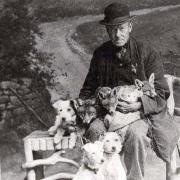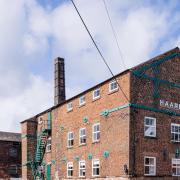Mike Smith talks to Peter Thornton about his recently released book
On Saturday, 6th June 1987, Peter Thornton left his lovely converted farmhouse in the Derbyshire village of Wensley and set out on the 15-mile journey to his office in the Belper factory where Thorntons’ chocolates were made. Peter noted that it was ‘a beautiful morning, with the hills of the Derbyshire Dales rolling off into the distance.’ Normally, he would have been uplifted by such a scene but he was deeply distraught on this occasion, because he knew that the bright dawn marked the beginning of what would be the darkest day in his life.
The story leading up to that unforgettable day is told in Peter’s recently published book Thorntons, My Life in the Family Business. With its simple title, mouth-watering cover picture of Thorntons’ chocolates and back-cover image of a smiling Peter, the book could easily be mistaken for the self-congratulatory memoir of a man who has spent his life in a business that has grown from a corner shop into a company with 379 shops, 200 franchises and a �214 million turnover. However, any such notions are quickly dispelled by the three introductions that have been specially written for the book.
Thriller writer Stephen Booth calls the story ‘a gripping family saga, packed with enough tragedy, triumph and conflict to make many novelists green with envy’; Alistair Blair of Investors Chronicle describes it as ‘a great page-turner’ and comedian Jo Brand calls the autobiography ‘a warts and all account of life at the choc face’. After reading the book and also hearing Peter’s tale in a face-to-face interview and as a member of the audience at one of his talks, I believe the praise is justified. Rather than losing impact on retelling, the story gains, not only in its messages about the running of a family business, but also in its perceptions of leadership, sibling rivalry, depression and the nature of love.
The history of Thorntons’ Chocolates dates back to 1911, when Peter’s grandfather, Joseph William Thornton, opened a ‘Chocolate Kabin’ at the corner of Howard Street and Norfolk Street in Sheffield. The ingredients of his business were personal service, inviting window displays and quality products. Thanks to this successful recipe, he was soon opening a second shop and a small manufacturing base.
After Joseph’s death in 1919, the business passed to his two sons. Norman, who had left school at 14, became manager of the shops and Stanley, who had studied food science at Sheffield University, took care of manufacturing. The brothers had contrasting personalities and were forever bickering, but their partnership worked because they had defined roles and contributed different skills to the firm, which became a limited company in 1921. By the end of the Second World War, they had established a chain of almost 40 shops and were about to open a factory in Belper to supplement their chocolate factory in Sheffield.
Problems began with the entry into the firm of the next generation, comprising Norman’s sons, Tony, Peter and John, and Stanley’s son, Michael. With Norman and Stanley clinging on to controlling roles well into old age, this meant that there were half a dozen people sharing power – two had been company; six became a crowd. Like his brothers and his cousin, Peter had always assumed that he would enter the family firm and this was confirmed when his father sent him on a confectionery course. Although ‘the boy had been fitted to the career, rather than the career to the boy’, his early days in the company were happy ones. He began on the shop floor of the Belper factory, which was being run by his older brother Tony, whom he looked upon as his ‘dashing hero’, particularly as he provided the Triumph TR2 for the daily journey from their Sheffield home.
After serving his ‘apprenticeship’ at Belper, Peter was asked to take over the chocolate department in Sheffield. As Norman and Stanley would never purchase new equipment at that time, Peter’s skill in buying and improving second-hand machines proved invaluable. He also introduced a new regime of systems management and formed close and supportive relationships with all his employees. In the space of little more than a year, he had increased production five-fold.
Given his success, Peter was understandably ‘flabbergasted’ when his father ordered him to give up his role on the grounds that he had taken ‘more than his fair share of the family business’. Recalling his sidelining to a job in charge of quality control, he said: ‘I had always felt undervalued by my father, who ruled his family in a cold, dictatorial way. Now, he had removed me from the job I loved. To make matters worse, I had become depressed after being rejected by a girlfriend to whom I was devoted. In an attempt to avoid drowning in a sea of self-pity, I joined the Territorial Army and started to spend most weekends with my new comrades.’
Eventually, Peter entered into a new relationship and got married. After his spell in charge of quality control, he became production manager at the Belper plant, with Tony taking charge of the shops and Michael assuming financial control. The newly-weds moved to Ashover and Peter threw himself into his new job. Regarding his staff as a ‘de facto family’, he set about improving their conditions and establishing a workers’ council. He even found the nerve to tell his father to stop pushing him around.
However, this period of contentment did not last. Although Peter’s showdown with his father resulted in an improvement in their relationship, it had the opposite effect on his relationship with Tony, to the extent that the two brothers now rarely spoke. Meanwhile, Peter had reluctantly surrendered control of the engineering side of the Belper factory to his younger brother John, who had joined the family firm after graduating from Cambridge. John was loath to take orders from Peter and it soon became obvious that the two men simply could not work together. When he became personnel director, Peter decided to bring in a consultant in an attempt to iron out the family tensions that were affecting the running of the firm but, crucially, he failed to invite John to the meeting with the mediator.
Mercifully, Peter and John became separated in subsequent organizational merry-go-rounds. Peter took on retailing and marketing, before becoming groupdevelopment director, when he tried with everything he knew, but without much success, to break into the US market. His personal life also took a new turn with his re-marriage and his purchase of a house in the pretty village of Wensley. Unfortunately, it was not long before this second marriage began to flounder.
By this time, Peter was chairman of Thorntons. The company’s Continental Assortment and their Special Toffee had an enviable niche in the confectionery market, as they still do, but there were strong tactical disagreements in the board room, particularly about going public and about John’s proposal to build a new factory at Alfreton. Peter argued for an extension to the existing Belper site, rather than a new build; he also felt that the ‘family culture’ that he had fostered among the staff and the personal service in the shops were both being undermined.
In 1987, Peter accompanied his mother and Stanley to the marriage of his nephew in New Zealand. On his return, he discovered that his fellow directors had used their combined voting power to force him out of the company. On June 6th, he went to his office for the last time and cleared his desk. With 35 years of passionate service to the family firm at an end and his second marriage now in tatters, Peter sank into depression once again.
After seeking help from a psychotherapist, he was diagnosed as exhibiting a dual personality, which had seen him hovering between the cheerful personality of his mother and the withdrawn nature of his father. As well as being prompted to become more like his mother, he was reminded that contentment in marriage would only come with a partner who would be happy to share his interests.
Seventy-six-year-old Peter now lives happily in Devon with his third wife and their two children. In addition to writing his life story, he has interests in three start-up businesses and he draws on his experience to give advice to family businesses. Knowing that Thorntons flourished and prospered despite its dysfunctional leadership, he is still a great believer in family firms, but he argues that older members should plan carefully for the next generation and surrender their voting rights at the age of 70. He also advises that outsiders should be brought in, not only to diagnose the strengths of family members, but also to mediate between them.
Peter hopes that his book might even help members of his own family to reconcile their differences and begin talking again. After a few early false starts following his departure from the company, Peter has now found happiness and fulfilment. It could be argued that June 6th 1987, which seemed such a dark day at the time, actually marked a new dawn in his life.
Thorntons, My Life in the Family Business by Peter Thornton is published by Tomahawk Press, �14.99 (www.tomahawkpress.com)


























